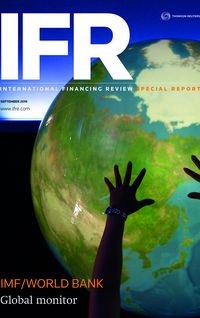The World Bank may have completed a landmark offering of bonds denominated in Special Drawing Rights, the IMF’s synthetic reserve currency, but it faces tough challenges if it is to become a viable market for other issuers.
China has been calling for the greater use of Special Drawing Rights as a way to challenge the hegemony of the US dollar, and officials are determined to introduce a functioning SDR bond market under its presidency of the G20 this year.
Zhu Jun, director general of the international department at the People’s Bank of China said at the G20 meeting in Chengdu in late July that the first SDR bond from an international organisation would be issued in the PRC’s interbank bond market as early as the end of August, mainland media group Caixin reported.
“Initially, SDR-denominated bonds will be of particular interest to official investors, but, gradually, they will also attract investors from private sectors. In such a way, an SDR bond market will be developed,” she was also quoted as saying.
Right on cue, the World Bank sold SDR500m (US$700m) of three-year notes at 0.49% in the interbank bond market through ICBC, CCB, CDB and HSBC (China). They were marketed on August 31 at an indicative price range of 0.40%–0.70%, ahead of the renminbi’s official entry into the SDR basket in October.
The bonds were 2.5 times oversubscribed on 50 or so orders, with bank treasuries taking 53%, central banks and official institutions 29%, securities companies and asset managers 12% and insurers 6%.
Shanghai zone
Market participants say the PBoC has been intensively studying the concept of SDR bonds for months and, thanks to its strong impetus, potential issuers have lined up, including both international organisations and Chinese banks.
China Development Bank is thought to be looking at the Shanghai Free Trade Zone, where a pilot scheme gives foreign investors direct access to some onshore bonds, as the venue for its potential SDR bonds.
One banker at a major debt underwriter said the China-led Asian Infrastructure Investment Bank may also look to issue SDR bonds.
Meanwhile, Chinese official newspaper Economic Information Daily reported in August that ICBC Asia was considering issuing SDR-denominated notes, citing unnamed sources. Bankers said this will be unusual, as most issuers of SDR bonds have tended to be supranational agencies or sovereigns.
If those deals come through, China’s SDR sector might quickly eclipse the first stirrings of the SDR bond market some 40 years ago. According to a July 15 IMF staff note for the G20, SDR-denominated assets were first issued in 1975 and reached a peak in the early 1980s. SDR-denominated bonds worth a total SDR563m were issued until 1981, but no new SDR bonds or credits have been issued since, according to the note.
Some analysts expect the bonds to be settled in renminbi and issued under Chinese law. This may make them less attractive to global central banks that are the natural buyers of SDR bonds, though it may provide a way for domestic investors to diversify.
“If the upcoming SDR bonds on the CIBM are settled in CNY, it will provide domestic investors with exposure to foreign currencies without the need to exchange for those currencies, thereby potentially reducing capital outflows,” said Frances Cheung, head of rates strategy, Asia ex-Japan, at Societe Generale.
Hurdles
Market participants, however, remain sceptical, pointing to many technical difficulties involving pricing, settlement and currency hedging.
SDR interest rates are based on the short-term money market rates of currencies in the basket, with no benchmark for longer term pricing.
Since the IMF reviews the SDR basket composition every five years, this could add foreign exchange risk to SDR bonds with tenors of more than five years.
For the week of September 5–11, the interest rate on the SDR was 0.05%, according to the IMF website, which does not look attractive to Chinese investors, who can buy one-year domestic treasury bonds at 2.153%. The true interest rate for SDRs should have been even lower, at –0.0518%, based on the composite rates of the three-month government yields in each currency, but the IMF has imposed a minimum floor.
On top of that, hedging costs and risk management will be very complicated for issuers.
“If you swap SDR and settle in CNY but have to go to the last leg to US dollars, swap banks have to figure out how to price the bonds accurately and offer a hedge,” said a banker.
“If you make interest payments, even if the coupons are fixed, you also have to ensure the accurate amount of renminbi is paid out, and the renminbi rate is influenced by the underlying FX rates of the other currencies.”
Expecting huge uncertainties and difficulties, very few are optimistic about the prospects of the China-driven SDR bond market.
“This is really going to be a small market and we have to yet to see whether this will develop or whether it will just be a flash in the pan,” the banker said.
To see the digital version of this special report, please click here
To purchase printed copies or a PDF of this report, please email gloria.balbastro@tr.com


